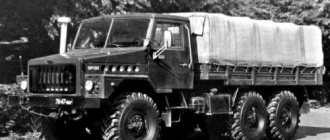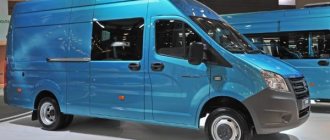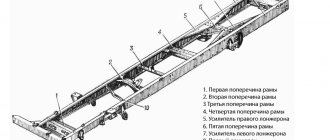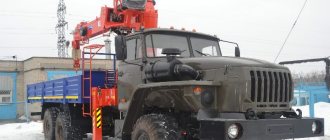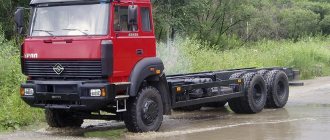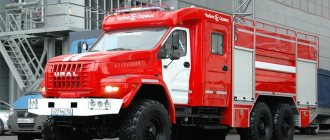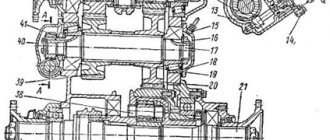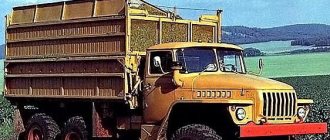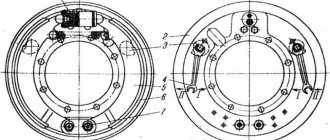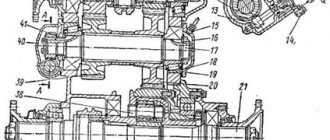Heavy trucks "Ural" firmly occupy a leading position in their class. Reliability, maneuverability, unpretentiousness in operation, maneuverability - these are the main qualities of cars of this brand. This article presents the Ural-5323 vehicle, the technical characteristics of which make it possible to successfully solve many problems in the oil and gas, logging, military and civilian fields.
Over the years of production, changes were constantly made to the design of the car aimed at improving its performance and driving characteristics, and the power of the power plant was increased. Its commonality with the previous production model is 75%, and with the subsequent one - about 90%. Today, new modifications of the vehicle continue to be created on the basis of the Ural-5323 chassis. Below we will look at its basic version.
Table: technical characteristics of Ural-5323
| Weight parameters of the onboard vehicle | |
| Vehicle curb weight | 11,850 kg |
| Load capacity | 10,000 kg |
| Gross dump truck weight | 22,050 kg |
| to the front axle | 10,095 kg |
| on the rear trolley | 11,955 kg |
| Platform internal dimensions | |
| Length | 5685 mm |
| Width | 2330 mm |
| Height | 1000 mm |
| Platform | Metal platform with a folding tailgate. Equipped with removable arches and awning. Middle removable and side folding benches. |
| Fuel tank capacity | 300+210 l |
| Wheel formula | 8×8/4 |
| Transmission | YaMZ-238UZ, mechanical, 8-speed, 3-way. |
| Maximum speed | 80 km/h |
| Transfer case | 2-speed manual with lockable center differential. |
| Engine | YaMZ-238B, YaMZ-7601.10 |
| YaMZ-238B | Diesel, V-shaped, 8-cylinder with turbocharging. |
| YaMZ-7601.10 | Diesel, V-shaped, 16-cylinder with turbocharging. |
| Tires | OI-25, 1260 mm *370 mm *508 mm, 146G (KAMA-1260) |
Cars Ural-4322/5323
(1978 – 1993)
The promising family of air-transportable trucks "Susha" was created by the Ural Plant since April 1977, taking into account the experience of operating serial three-axle vehicles and the development of the first experimental generation 379/395, including their unique amphibious variants.
With the commissioning of the Kama Automobile Plant and its engine production, initially the Susha range was optimistically supposed to be equipped with the entire series of unified V-shaped diesel and multi-fuel KamAZ engines with the same cylinder diameter and piston stroke (120 mm each) and the number of cylinders 6, 8 or 10, as well as transmission and chassis components produced by YaMZ. The realities turned out to be not so optimistic: KamAZ was able to establish mass production of only one 8-cylinder diesel engine, which was subsequently equipped with all KamAZ vehicles and army Ural-4320. In 1978, the plant assembled the first basic three-axle bonneted vehicle " Ural-4322 " (6x6) of the "Susha" family with a lifting capacity of 5.5 tons (later with a winch - 5.0 tons), created on the basis of the serial truck "Ural-4320" » with a wheelbase of 3525+1400 mm and a new all-metal cargo platform 4500 mm long. The long-wheelbase version 4322B with a payload of 5.5 - 6.0 tons and a distance between the centers of the front and middle axles of 3800 mm was made on the 4320 chassis extended by 275 mm. Externally, these cars differed from the serial production by new cabins, tail surfaces and front facing with vertical welded radiator grille. Like the most common Ural-4320, they were equipped with a KamAZ-740.10 diesel engine, V8 (10.85 l, 210 hp), a double-disc clutch, a 5-speed gearbox, an internal pressure regulation system in 20-inch tires, 24-volt electrical equipment, two fuel tanks with a total capacity of 259 liters and a high air intake pipe on the right side of the cab. At the same time, a pneumatic amplifier appeared in the gearbox control system, the traction force of the winch was 6 - 8 tf (depending on the sequence of turns), and additional sealing of the main units and the cabin made it possible to increase the fording depth to 1.75 m. Increasing the wheelbase of the model 4322B led to the installation of a new all-metal cargo platform 4694 mm long with an awning that could accommodate up to 33 troops. At the same time, the increase in the overall length of trucks to 8050 mm had virtually no effect on cross-country ability. The curb weight of the 4322 cars reached 9050 kg, the gross weight was 14,850 kg, the maximum speed was 85 km/h, and the range was 840 km. They could tow trailers weighing from 7.0 to 11.5 tons on roads with different surfaces. In the same 1978, the first experimental three-axle cabover truck 4322A with a modified cab from KamAZ and a hooded truck tractor 4422 were built. Later, a second one appeared in this series tractor 44221 with a power take-off, designed to work with the active semi-trailer "Ural-862", and multi-purpose short-wheelbase chassis 43224 with an installation frame length of 4461 mm.
Basic 5.5-ton army truck " Ural-4322 " with a 210-horsepower KamAZ V8 diesel engine. 1978
A prototype of the Ural-4322A with a cab from KamAZ vehicles. 1978
Simultaneously with the three-axle vehicles, two prototypes of the Ural-5322 (8×8) cabover tractor-trailer with a lifting capacity of 8.5 - 9.0 tons were assembled. It was created as a modernized version of the first four-axle vehicle "Ural-395" with the expectation of using a more powerful 10-cylinder diesel engine, which was supposed to be mass-produced at the engine department of the Kama plant. The vehicle was equipped with a tilting steel cab, which in terms of external panels and internal equipment was unified with the cab of KamAZ trucks, but was distinguished by a modified front facing. The main design feature was the experimental KamAZ-741 V10 engine with a power of 260 hp, generally identical to the YaMZ-741 model and assembled in several test copies at KamAZ. The prototypes were equipped with a 5-speed gearbox and a two-speed transfer case, a balanced spring suspension, a winch, a tire pressure regulation system and a metal cargo platform with an awning. They had a curb weight of 10.8 tons, towed trailers with a total weight of up to 10 tons and reached speeds of 80 km/h on the highway. Insoluble problems with putting into mass production the complex, heavy and less economical V10 engine put an end to the fate of the original car , which was soon replaced by the updated 5323 range with a V8 engine.
The most interesting cars in the first range of the “Sushi” family in 1978 were also secret trucks, adapted to overcome deep water obstacles afloat and which became a development of the 379/395 series cars. Externally, they also hardly differed from ordinary land vehicles , although they were distinguished by high, sealed all-metal bodies that provided buoyancy, and removable front water-reflective shields. Two propellers were located under the rear of the cargo platform and received torque from the vehicle's power take-off. In the three-axle floating series there was an experimental 4-ton vehicle 43221A (4322P) with a winch, a sunroof and two fuel tanks, capable of moving on the highway at the speed of conventional trucks (85 km/h) and having a cruising range on land of 1040 km. To prevent water from entering the engine compartment, a special shield with an internal air duct for cooling the radiator was installed in front of the radiator. At the same time, a 7-ton floating version 53221 (5322P) with a power reserve of 1000 km was created on chassis 5322. On the water, a truck converted in this way without floats was immersed in the water to the level of the hood and moved by propellers and rotation of all wheels.
A prototype of the Ural-5322 (8x8) car with a promising KamAZ V10 diesel engine. 1984
Modernized 4-ton amphibian " Ural-43221A " with two propellers. 1979
In September 1979, experimental vehicles of the “Susha” family arrived at testing ground 21 of the Research Institute for testing on land and in its own reservoir, then traveled over 30 thousand km along public roads and desert regions of the Turkmen SSR, and the amphibians also underwent factory testing on Lake Turgoyak Chelyabinsk region. Based on their results, in 1980, cars of almost all types received recommendations for adoption and mass production. The exception was the land version 5322, although its testing and development continued until 1984.
By the mid-seventies, about 10,000 German Magirus-Deutz trucks with air-cooled engines, purchased in 1974 under the “contract of the century,” were working on the construction of the Baikal-Amur Railway (BAM). Such power units proved themselves to be excellent in the eastern regions of the USSR; they were simpler, lighter and cheaper than liquid-cooled diesel engines and could operate smoothly in extreme temperature conditions. In the wake of the enormous success of the Magirus, in 1982 they purchased a license for the F8L413 V8 diesel engine (11.3 liters, 232 hp), developed back in 1969, and then formed a joint venture to assemble it in the USSR. On the initiative of chief designer A. A. Romanchenko, they decided to establish serial production of engines at the Kustanai Diesel Plant (KDZ) of the Kazakh SSR, which had been built since 1981 with a production capacity of 40 thousand engines per year, which was then part of the UralAZ Production Association. In 1986 - 1987, prototypes of the Ural-744.10 air-cooled V8 engines with a power of 234 hp were assembled at a still unfinished enterprise. This made it possible in 1987 to introduce a new long-wheelbase 6-ton multi-purpose hooded truck 43223 with a wheelbase of 3800+1400 mm, which became a continuation of the Susha family. The first editions had a narrowed welded radiator grille; subsequent production cars had a new stamped lining. Externally, the car was distinguished by a high air intake pipe of the cooling system on the left side of the cabin, equipped with an autonomous heater and a sprung, adjustable driver's seat. It had an all-metal 4.7-meter side platform with short wheel wells and a flat floor, as well as a modernized 8-ton winch with a cable output forward and backward. On the highway, the truck reached a speed of 93 km/h; on various types of roads and terrain it could tow trailers weighing 10.0 - 11.5 tons. Average fuel consumption was 34 liters per 100 km. In addition, long-wheelbase 5.5-ton chassis 43222 were created for mounting standard habitable bodies K-4322, version 43225 for installing army superstructures and bodies K2.4320, as well as civilian dump trucks 55223 and 55224 with a carrying capacity of 7.2 and 10 tons.
In 1990, small-scale production of engines finally began at KDZ, and in June 1992, the Ural Automobile Plant began industrial production of the main models of trucks and chassis of the 4322 series with KamAZ-740 and Ural-744 engines. In the same year, the joint venture with, which remained on the territory of independent Kazakhstan, collapsed and stopped producing power units. In three years, KDZ was able to assemble only 405 engines, so we can assume that the number of complete 4322 series trucks was slightly less. One of the last vehicles in this range in 1993 was the civilian short-wheelbase three-axle truck tractor 44223 (wheelbase 3525+1400 mm) with an extended cabin and rear gable wheels, which was supposed to be used in conjunction with the Ural-9516 semi-trailer with a load capacity of 13.5 - 15 ,0 t. A relatively small number of Ural-4322 vehicles that entered service with the troops were withdrawn from service in September 1998.
Multipurpose truck " Ural-43223 " with an air-cooled diesel engine. 1987
A promising car " Ural-5323 " with a 260-horsepower KamAZ V8 engine. 1989
In the eighties, the development of the first four-axle vehicle 5322 became the 9-ton truck 5323 of the Susha family, equipped with a new 260-horsepower KamAZ-7403.10 V8 diesel engine with turbocharging, a 5-speed gearbox, its own two-speed transfer case and a winch. Increased cross-country ability and smooth running were ensured by balanced spring suspensions of the front steered wheels with hydraulic shock absorbers and the rear drive bogie. Its cabin was also unified with KamAZ vehicles, equipped with an effective ventilation system, a heater and an adjustable driver's seat, but outwardly differed in a number of front facing elements. The weight of the towed trailer on roads of all categories and on terrain was 10 tons, the maximum speed was 88 km/h, and the range was up to 1000 km. Work and testing of the 5323 continued until the end of the 1980s and led to the release of the first trial batch in 1989. Serial production of this range began already in the 1990s, but these were already significantly modernized vehicles with a new power unit. After a devastating fire in the engine department of KamAZ, which broke out on the night of April 14-15, 1993, the plant hastily refocused on the new 300-horsepower YaMZ-238B V8 diesel engine, which began to be installed on modernized vehicles 532301 and 532302 with different cabs.
So, at about the same time, the end was put to the use of both licensed Deutz engines and KamAZ engines in military “Urals”, which led to a stop in work on the promising army “Susha” family. Subsequently, it was replaced by a new generation of Motovoz vehicles, which included two-, three- and four-axle army trucks with YaMZ engines and transmissions.
Overcoming obstacles
The ground clearance of the Ural-5323 is 400 mm, which makes it possible to overcome obstacles of varying degrees of complexity. The car can overcome a ford up to 1.75 m deep, a ditch up to 1.2 m wide, as well as vertical obstacles, the height of which can reach up to 0.55 m. Thanks to the high engine power, the car can easily overcome steep climbs with a slope of up to 58%.
Merger of grandees
Thanks to the merger of several giants in 1994, a new enterprise appeared, called Iveco-UralAZ. It was formed from the following corporations:
- Ural Automobile Plant.
- Italian company IVECO.
- RAO Gazprom (Russia).
The new enterprise was engaged in the production of cars using joint developments in this direction. The first model to roll off the assembly line was the dump truck of the same name, on which an Italian cab was installed. Unfortunately, it was not possible to deliver it to the place where the tests were planned to be carried out. During transportation, the vehicle's cabin was damaged.
Engines Ural-5323
Characteristics of the engines (two types are installed on the modern Ural) YaMZ-238B and YaMZ-7601.10.
YaMZ-238B
An eight-cylinder turbocharged diesel engine with a V-shaped cylinder arrangement, producing 300 horsepower, was first delivered to the Ural in 1993. Since then it has established itself as one of the best engines of this type. The engine capacity is 14,860 cc. see Liquid cooling system.
YaMZ-7601.10
Since 2004, the line of engines installed on the Ural-5323 has been replenished with the six-cylinder, V-shaped engine YaMZ-7601.10. With a working volume of 11,150 cubic centimeters, its power is the same as that of the YaMZ-7601.10 and also amounts to 300 horsepower.
By reducing the engine size and maintaining the traction and power of the Ural-5323, the technical characteristics became better and it was possible to reduce diesel fuel consumption. The engine complies with Euro-2 environmental standards, fuel consumption has become 43.5 liters per 100 kilometers. According to the manufacturer, the engine has a large margin of safety and can last up to 800 thousand kilometers without major overhauls.
History of creation
The ancestor of the Ural-43206 is the truck of the Ural-4320 line. This model was first released from the assembly line on November 17, 1977. In fact, the Ural-43206 has undergone a minimal number of external changes. However, its outstanding technical characteristics are the result of extensive modernization.
The most important differences between the Ural-43206 and its progenitor Ural-4320 include:
- a specially designed fuel injection system - thereby reducing consumption;
- increased wheelbase (4405 mm versus 3525 mm for the Ural-4320);
- modified cab (models with 4 doors exist);
- Some vehicles are equipped with an IVECO cabover cab.
Initially, the car was equipped with KamAZ-740 engines. But as a result of certain economic difficulties, since 1993 this series of cars began to be equipped with units produced at the Yaroslavl Motor Plant. Models YaMZ-236 and YaMZ-238 were used. The next stage in the development of this area of automotive industry is “Ural NEXT”.
Chassis
The Ural-5323 chassis uses a dependent suspension, balanced on both the front and rear bogies. The front suspension is made on longitudinal springs, with hydraulic shock absorbers and reaction bars. The rear suspension is made up of two semi-elliptic springs, springs and telescopic shock absorbers.
The use of a balancer suspension made it possible to more evenly distribute the load on the ground and increase the maneuverability and smoothness of the vehicle.
Device
The basis of the car is a load-bearing riveted frame made of high-strength steel and characterized by increased rigidity. The design provides short rear and front overhangs, thereby increasing cross-country ability. The platform for transporting people and cargo is made of metal. It has lift-up side seats and an opening tailgate. The body assumes the possibility of installing an awning, arches and mounting sides on both sides. Some modifications received a wooden platform. The sides of the Ural 4320 are lattice or solid. The design provides for a front location of the unit. To access the engine, the hood opens upward. On the sides there are wide, flat fenders that protect the cabin from foreign objects and dirt while driving.
The truck has a 6 by 6 wheel arrangement. The model is equipped with single wheels with automatic adjustment of the air filling of the chambers on 3 drive axles. Recommended tires: 14.00-20 OI-25.
Ural 4320 has a dependent front suspension on semi-elliptic springs. It consists of 2-way shock absorbers. The rear suspension of the car is also dependent (on springs with reaction bars). All truck axles are drive axles. The steered wheels are located on the front axle.
The car is equipped with a friction clutch with a drive equipped with a pneumatic booster. The 2-speed manual transfer case has a permanently connected drive to the front axle. The Ural 4320 is equipped with a fully synchronized transmission produced by the Yaroslavl Motor Plant. The gearbox has 5 speeds, switched mechanically.
The brake system includes a dual-circuit working and single-circuit spare brake system. There is also an auxiliary braking system with pneumatic drive from the exhaust system. The mechanical parking brake system is equipped with a brake drum on the transfer case.
At the rear of the frame and at the front of the rigid bumper there are powerful towing devices made in the form of a towing mechanism and hooks. Thanks to this, the technical characteristics of the model were improved.
The developers of the Ural 4320 also took care of the driver. The steering in the latest models has a hydraulic booster. The cabin is equipped with a heater that maintains normal temperature in cold weather. The driver's seat is adjustable in 3 directions (up-down, forward-backward and backrest tilt). The instrument panel is located at a convenient distance from the driver. The instruments are easy to read, and the driver can reach the switches and buttons without getting up from the seat. The truck has a convenient and large glove compartment and a shelf for storing items. There is a document box under the passenger seats.
In the basic version, a 3-seater cabin made of stamped sheet metal is mounted on the frame. Thoughtful glazing guarantees good visibility and allows you to control the situation on the road. Large rearview mirrors also help with this.
Other types of cabins are also available:
- 3-seater all-metal 2-door cabin;
- 3-seater all-metal 2-door cabin with sleeping bag (this option is currently discontinued);
- modern spacious bonnet-type cabin with a sprung driver's seat and plastic tail;
- cabin based on the GAZelle Next module (3- and 7-seat versions are available).
Options include luxury cabins, a differential lock system, ABS, battery compartment insulation, an additional tank and a traction winch.
Chassis modifications
Many modifications have been created based on the Ural-5323 chassis. The most famous is the onboard Ural-532301/02. The technical characteristics of the base chassis made it possible to create the multi-purpose chassis “Ural-532341/42”, intended for the needs of the military-industrial complex, “Ural-532361/62” - a long-wheelbase chassis for installing engineering equipment and the Ural-542301/02 truck tractor.
In 2000, chassis 5323 served as the basis for the production of the first Russian truck, “Ural-532303” (aka “Ural-5323-23”) with an armored cab capable of withstanding a 7.62 caliber bullet fired both at point-blank range and from a distance of 300 -400 m, and fragments weighing up to 5 grams.
Cranes, pile driving and repair and recovery vehicles, fire tanks, crew buses, dump trucks, water treatment stations and many other tasks are implemented on the basis of the Ural-5323 vehicle. The characteristics of the machine turned out to be truly in demand in many industries and the military-industrial complex.
